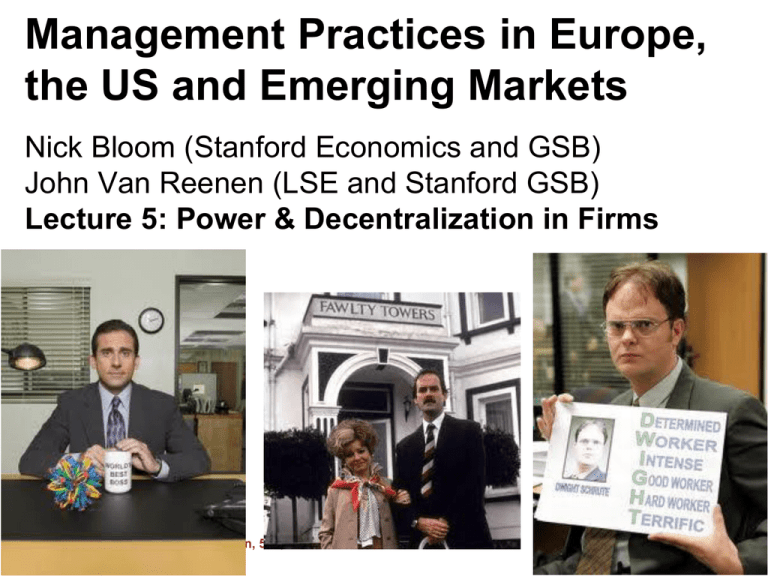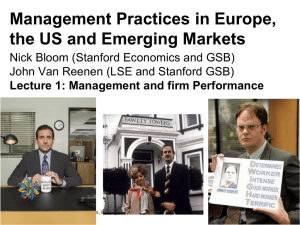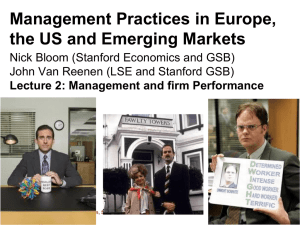Lecture5_591_2012 - World Management Survey
advertisement

Management Practices in Europe, the US and Emerging Markets Nick Bloom (Stanford Economics and GSB) John Van Reenen (LSE and Stanford GSB) Lecture 5: Power & Decentralization in Firms Nick Bloom and John Van Reenen, 591, 2012 1 • What is decentralization? • Alibaba Case • Decentralization & learning • Measuring real authority • Factors affecting decentralization Nick Bloom and John Van Reenen, 591, 2012 What is decentralization? • One aspect of firm organization - how power and decision making are distributed • Unlike basic management practices no typical “good” and “bad” – just different styles which tend to vary by country • Why should you care: – Key in designing your business or advising others – Changing over time, generating broader economic effects, like increased inequality and worker empowerment Nick Bloom and John Van Reenen, 591, 2012 Formal vs. Real Authority • Formal authority in the organization chart (“organogram”) – E.g. Profit centers vs. cost/sales centers • Real authority – How things actually get done. Power – http://www.youtube.com/watch?v=5FRVvjGL2C0 • Can be different across different types of decisions – e.g. Investment, pricing, products Nick Bloom and John Van Reenen, 591, 2012 Real authority models: Centralized http://www.youtube.com/watch?v=wBIov_CSqyI&feature=related Nick Bloom and John Van Reenen, 591, 2012 Real authority models: Decentralized e.g. Universities Nick Bloom and John Van Reenen, 591, 2012 • What is decentralization? • Alibaba Case • Decentralization & learning • Measuring real authority • Factors affecting decentralization Nick Bloom and John Van Reenen, 591, 2012 Questions on the Alibaba case • What does Alibaba do? Nick Bloom and John Van Reenen, 591, 2012 Questions on the Alibaba case • Is the current degree of competition/decentralization among the business units appropriate? Nick Bloom and John Van Reenen, 591, 2012 Questions on the Alibaba case • Do you think that Jack Ma should encourage more cooperation? If so, how? Nick Bloom and John Van Reenen, 591, 2012 Questions on the Alibaba case • Where should the new business initiatives (mobile platforms and financing small businesses) reside organizationally? At corporate or within the individual business units? Nick Bloom and John Van Reenen, 591, 2012 Questions on the Alibaba case • What does the Talent Myth tell us about the risks of decentralization? Nick Bloom and John Van Reenen, 591, 2012 • What is decentralization? • Alibaba Case • Decentralization & learning • Measuring real authority • Factors affecting decentralization Nick Bloom and John Van Reenen, 591, 2012 Decentralization (into profit centers like Alibaba) • Learning Theory: CEO decentralizes when knowledge of local managers very important. Decentralize when: 1. Firm is young (less experience to draw on) 2. Firm uses more advanced technology 3. Industries are more volatile & changing quickly (heterogeneous – harder to learn from others) • Evidence – Consistent with Alibaba – Acemoglu, Aghion, Lelarge, Van Reenen, Zilibotti (2007) look at 1,000s of French and British firms. Ran econometric models with many controls Nick Bloom and John Van Reenen, 591, 2012 14 Younger firms are more decentralized Nick Bloom and John Van Reenen, 591, 2012 15 More technologically advanced firms more likely to be decentralized Nick Bloom and John Van Reenen, 591, 2012 16 Firms in more volatile sectors (bigger variance of productivity shocks) are more likely to be decentralized • What is decentralization? • Alibaba Case • Decentralization & learning • Measuring real authority • Factors affecting decentralization Nick Bloom and John Van Reenen, 591, 2012 Example A: Domestic Firm 2 Sites, Single Plant Central HQ (New York Site) D, Decentralization Plant (Albany Site) Nick Bloom and John Van Reenen, 591, 2012 Example B: US Domestic Firm Multi-Site, Multi-Plants Central HQ (New York Site) D1 D2 D3 Plant 1 Plant 2 Plant 3 (Buffalo Site) (Albany Site) (Scranton Site) Nick Bloom and John Van Reenen, 591, 2012 The Decentralization Survey Page Nick Bloom and John Van Reenen, 591, 2012 Our empirical decentralization measure • Main measure averages the z-score (scores normalized to mean 0, standard-deviation 1) of each variable: – Hiring senior employees (discrete, 1 to 5) – Maximum Capital expenditure (continuous, in $) – Introduction of new products (discrete, 1 to 5) – Sales and marketing (discrete, 1 to 5) Nick Bloom and John Van Reenen, 591, 2012 e Greece Decentralization varies heavily across countries Japan India China Poland France Portugal Most centralized Greece Italy Germany UK • Asia US n Japan Sweden -1 a India a China d Poland e France l Portugal y Italy -.5 0 mean of zorg .5 • Southern Europe Least centralized • Scandinavian countries • Anglo-Saxon countries y Germany K UK S US n Sweden -1 -1 -.5 -.5 0 0 mean of zorg mean of zorg Decentralization measure .5 .5 • What is decentralization? • Alibaba Case • Decentralization & learning • Measuring real authority • Factors affecting decentralization Nick Bloom and John Van Reenen, 591, 2012 Larger Firms: More or less decentralized? 100-200 200-500 500-1000 1000+ Number of employees in the firm 0 .2 .4 .6 .8 1 Larger Firms are more decentralized 50 100 200 500 1000 100-200 200-500 500-1000 1000+ Number of employees in the firm Firms with more skilled workers? Under 20% 20%-40%40%-60% 60%-80% 80%-100% Proportion of employees with a college degree Nick Bloom and John Van Reenen, 591, 2012 27 0 .1 .2 .3 .4 .5 Firms with more skilled workers are more decentralized (complements) 20 40 60 80 100 Under 20% 20%-40%40%-60% 60%-80% 80%-100% Proportion of employees with a college degree Nick Bloom and John Van Reenen, 591, 2012 28 Legal and Cultural Factors affecting Decentralization • Trust – Alibaba’s key competitive advantage was building trust with customers. – But trust more important generally? – In high trust areas (e.g. Sweden, US) managers likely to be trusted to carry out more activities than low trust (e.g. Southern Italy, parts of India) • Rule of Law – In strong rule of law areas (e.g. US) top management less worried about theft by middle management Nick Bloom and John Van Reenen, 591, 2012 29 Trust and decentralization • How to measure trust? World Value Survey (10,000s of individuals from different countries) asks question: “Generally speaking, would you say that most people can be trusted or that you can’t be too careful in dealing with people?” Trust by region of the country defined as % of people answering “yes” to first part of the trust question • Experiments show this question linked with trust/trusting behavior Nick Bloom and John Van Reenen, 591, 2012 Trust, rule of law and decentralization Trust (region) 1.196*** (0.429) 0.825*** (0.290) 0.732** (0.298) 3549 0.473*** (0.102) 3549 3549 no no no no yes yes Rule of law (country) Observations Country dummies Other controls Notes: Other controls are SIC3 dummies, noise controls (interviewer dummies Interviewee tenure and seniority, etc.), public listing, CEO onsite, plant size, competition Nick Bloom and John Van Reenen, 591, 2012 Also look at multinationals as another test of trust • Could worry about bias due to trust proxying for other country/regional variables • So look at affiliates of foreign multinationals and investigate whether trust in their home country also matters • Bilateral trust: (on average) how much do people in the multinational’s home country trust people in the country where the subsidiary is located (Eurobarometer Survey) Nick Bloom and John Van Reenen, 591, 2012 Decentralization and trust in multinational firms Trust (region of location) Trust (country of origin) 0.563 0.446 (0.843) (1.908) 0.749*** 0.152 (0.301) (0.152) Trust (bilateral from origin cty to location cty) 1.809*** (0.768) Full set of controls Yes Yes Regional dummies No No Country origin dummies No No Region Origin country 867 280 Clustering Observations Nick Bloom and John Van Reenen, 591, 2012 Does decentralization matter for economic performance? • Short run: generally depends on firms circumstances (e.g. country, industry and technology). • Long run: to be large you need some decentralization, so key for growth (Penrose 1959 and Chandler 1962) Nick Bloom and John Van Reenen, 591, 2012 Wrap-up • Alibaba shows the benefits of decentralization, but also costs • Initiative/incentives vs. co-ordination • Complementarity of organization with strategy (people, pay) and circumstances (high growth China, volatile technology) • Decentralization • Varies a lot within and between countries • Varies systematically technological, economic and cultural factors • More general importance for economics growth Nick Bloom and John Van Reenen, 591, 2012 35 Back-up Nick Bloom and John Van Reenen, 591, 2012 36 Decentralization also varies across ownership types – with founder and government firms centralized Government Founder Private Individuals Family, family CEO Other Managers Dispersed Shareholders Family, external CEO Private Equity -.4 -.2 Nick Bloom and John Van Reenen, 591, 2012 0 mean of zorg .2 Decentralization measure .4 0 .2 .4 .6 .8 Trust by country (means and regional spreads) UK Italy Greece Portugal Germany Poland France Japan India US China Sweden The graph shows median level of trust. The vertical bars denote Nick Bloom and John Van Reenen, 591, 2012 minimum and maximum levels. Decentralization also varies across firms France Germany Greece India Italy Japan Poland Portugal Sweden UK US 0 .5 1 1.5 0 .5 1 1.5 0 .5 1 1.5 China -2 0 2 4 -2 0 2 4 -2 0 2 4 -2 0 2 4 zorg located firm is 591, Country by and Graphs Nick Bloom John where Van Reenen, 2012 Decentralization measure (higher number is more decentralized) Are things really changing? "Globalization and the arrival of the information economy have rapidly demolished all the old precepts. The management of global companies, which must innovate simultaneously and speed information through horizontal globe-spanning networks, has become a daunting challenge. Old, rigid hierarchies are out ...." Business Week The 21st Century Corporation, cover story August 21-28, 2000. Nick Bloom and John Van Reenen, 591, 2012 40 Evidence is limited, but appears yes, firms are decentralizing Delayering – Number of positions reporting to CEO 7 SPAN 6 5 4 1985 1990 1995 2000 year Source: Rajan and Wulf, 2006, 300+ large US corporations Nick Bloom and John Van Reenen, 591, 2012 41 External validation – decentralization over time • Only prior firm decentralization measure to cross-check against we are aware of is from Hofstede – Surveyed c.100,000 IBM employees across 50 countries during the 1970s & 1980s – Questions on management style (autocractic/paternalistic or consultative) and preferences for delegation – Combined into Power Distance index (1-100), low means limited (preference for) delegation Nick Bloom and John Van Reenen, 591, 2012 ‘Power distance’ measures from 1970s & 1980s matches our 2000s decentralization data quite well .5 Sweden Decentralization -.5 0 US UK Germany Italy France Portugal Poland China India Japan Greece -1 Correlation= 0.80 20 30 40 50 60 Power Distance (100=low power distance) Nick Bloom and John Van Reenen, 591, 2012 Index Power distance 70 .5 Fiscal decentralization (whether Governments are centrally run) looks similar – so something cultural? US UK 0 Italy France Poland China India Japan Greece Correlation= 0.83 -1 Firm Decentralization -.5 Germany 0 1 2 Fiscal Decentralization Index 3 Fiscal Decentralization (Arzaghi and Henderson, 2005) Nick Bloom and John Van Reenen, 591, 2012 4 ICT has a mixed impact on decentralization Enterprise Resource Planning 0.104* 0.116** Information technology (0.054) (0.054) NETWORK -0.098* -0.110** Communication technology (0.053) (0.053) -0.041 -0.021 -0.031 (0.031) (0.031) (0.031) Computers/Employee • Information technology (IT) increase decentralization • Communications technology (CT) decreaseas decentralization Notes: Controls are SIC3 dummies, country dummies, noise controls (interviewer dummies Interviewee tenure and seniority, etc.), public listing, CEO onsite, plant size, Nick Bloom and John Van Reenen, 591, 2012 45 Example A: Domestic Firm 2 Sites, Single Plant Central HQ (New York Site) D, Decentralization Plant (Phoenix Site) Nick Bloom and John Van Reenen, 591, 2012 Example D Japanese MNE Global HQ (Tokyo Site) Do not observe D French CHQ Sweden CHQ (Paris Site) (Stockholm Site) Observe D Observe D Plant 2 (Lyon Site) Nick Bloom and John Van Reenen, 591, 2012 Plant 1 (Lund Site)









